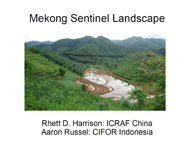
Mekong Sentinel Landscape
In the last two decades, Mekong economies have grown much faster than usual. Large infrastructure development has caused, and will continue to cause, dramatic changes in forest cover, land use patterns and regional ecosystem services. These changes will bring profound and widespread changes to both the physical and social environment. Recent debates among regional countries continue to focus on the commercial exploitation of natural resources, not the sustainable protection and provision of ecosystem services. These reasons signify Sentinel Landscape research is critical to the future of the Mekong region.
The Mekong is home to almost 100 distinct ethnic groups. The political and economic marginalization of these groups is a longstanding problem. Additionally, local, indigenous communities face increasing uncertainties as they strive to use and sustain the landscapes in which they depend upon. Among the most powerful contemporary forces that influence both local cultures and land use are various government policies with their emphasis on rapid expansion of regional, national and international markets.
Nation building and increased regional integration of ethnic minority areas has led to increased incomes as well created poverty. The challenges facing Mekong region ethnic groups are new and old, social and cultural, political and economic, national and regional.








